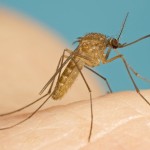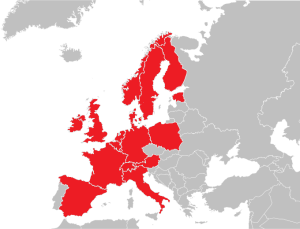
“While arboviruses do not generally cause recognisable disease in their arthropod vectors they often do in vertebrates, in particular warm-blooded vertebrates like primates like us and livestock. “ As classically defined, arboviruses have both arthropod and non-arthropod hosts. Whilst insects/ticks may have legs, jaws and eyes etc., they are clearly very different to their vertebrate hosts, such as humans and cattle. How one virus can survive within two vastly different biological systems is a fascinating story of evolution. And one that is critical to understand how we can treat and even prevent these diseases.
As the International Meeting on Arboviruses and their Vectors, being held in Glasgow with the Society for General Microbiology (#IMAV15) kicks off today, we’d like to present to you the fourth in a series of posts about arboviruses.
Dr Andrew Shaw, (@virusmuser) a postdoc in the Palmarini lab tells us the story of how arboviruses infect their vertebrate hosts and how they can fight back.
Breaking barriers
Vertebrate bodies have many physical defences to stop infections. Most importantly are the epithelial/mucosal barriers (respiratory tract, gut, reproductive tract and urinary tract) and our skin. Arboviruses are usually transmitted to a vertebrate during blood feeding by an infected insect/tick. By its very nature, this results in the virus finding itself in the blood of the new host, rather than in, for example, the respiratory tract in the case of a virus spread by aerosol. This means that our first defences have already been breached. Access to the blood stream allows potential complete systemic circulation of the virus in the vertebrate.

However, the blood stream of a vertebrate is no viral paradise. Immediately the virus is in a dramatically different environment to that in the arthropod vector and the most immediate difference is the temperature. Rather than the outside ambient temperature of the insect/tick, the virus now finds itself in an environment likely to be over ten/fifteen degrees hotter. Arbovirus particles must therefore be stable and able to replicate at both the ambient temperature of the environment (during the insect/tick stage), as well as warmer temperature in a (possibly feverish) animal host.
Prior to replicating though, the virus must necessarily enter a cell, and there can be fundamental differences here too. Insect and vertebrate cells are clearly different, and this includes the molecular repertoire expressed on the surface. Viruses must therefore be able to recognise distinct molecules in different species.
An alternative path to entering a cell is if it is engulfed by dendritic cells or macrophages – two components of a dramatic difference between arthropods and animals: the immune system. But our immune system is one of the best defences against these viruses.
Interferon to the rescue
Whilst the invertebrate cells largely rely upon the RNAi pathway to control viral infections (for more information see the upcoming post), vertebrate immune systems are by comparison hugely complex and multifaceted. A certain level of intrinsic immunity exists that provides an immediate resistance to virus infection. The most prominent would-be barrier to infection, the skin, is immediately overcome by the blood feeding nature of the insect. The immune system per se can be divided into the innate and adaptive arms. If a virus does manage to get inside a cell, it must then counter the innate/intrinsic immune system first.
“Some ISGs, so-called ‘restriction factors’, directly act to antagonise the virus infection, preventing its onward spread through the host.”
An innate immune response is triggered by the host first detecting hallmarks of an infection (pathogen associated molecular patterns (PAMPs)), which in the case of viruses includes double stranded RNA and 5’ triphosphate ends to RNA molecules. Once detected by the cell, signal transduction occurs leading to the expression and secretion of interferon – a cytokine capable of paracrine as well as autocrine signalling. Interferon signalling stimulates cells to up-regulate an arsenal of interferon stimulated genes (ISGs), the products of which result in the cells being placed in an antiviral state.
Some ISGs, so-called ‘restriction factors’, directly act to antagonise the virus infection, preventing its onward spread through the host. In turn viruses have thus evolved a number of ways to cope with the interferon response. Broadly speaking, the approach is to either prevent IFN being produced or to be able to cope with the response. To prevent a response a virus can either avoid detection, for example by adding a host-like cap to its RNAs, as with Orbiviruses, or actively preventing the synthesis of IFN beta, as occurs with the Bunyaviruses, such as Schmallenberg.
Importantly, these innate responses bide time for the other vertebrate immune response to kick in: the adaptive immune response with antibodies and T cells. None of which arthropod vectors have.
Our own worst enemy
As big as the difference may be between the arthropod and animal host, the response of an animal can vary at many levels, whether it be different species through to individuals in a population. For example, Crimean Congo haemorrhagic fever virus infects many types of mammal, but it is only in humans that devastating disease occurs.
“Ultimately we might not yet know the result of the biggest impact man has had: global warming.”
Although it may be the insects that transmit the virus between individuals, animals play their part in the maintenance and spread of viruses. Animals can harbour the virus a long time and can represent a wild reservoir, for example warthogs in Africa maintain African Swine Fever virus symptom free, whereas in domestic pigs the virus is lethal. The impact of animals upon the transmission of viruses is also of significance. In this respect, of all animals it is probably humans who have arguably had one of the biggest impacts.

One of the most frequently quoted examples is that of the tyre trade spreading the larvae and eggs of competent species of mosquito around the globe. However, there are much more mundane, day-to-day activities that can impact arbovirus outbreaks. Leaving empty cans to fill with water, for example, provides breeding grounds for mosquitoes such as Aedes albopictus, the vector of dengue, yellow fever and chikungunya viruses. Similarly, the trade in lucky bamboo has, like the tyres, taken A. albopictus to new parts of the globe.
Ultimately we might not yet know the result of the biggest impact man has had: global warming. Increasing temperatures means more parts of the world are suitable for larger outbreaks to occur for longer periods of time. Unprecedented outbreaks of bluetongue virus and Schamllenberg virus among ruminants have already arrived and swept through Europe. The question is, what’s next?
*********************************************************************************************************************
The MRC-University of Glasgow Centre for Virus Research will host the 2015 International Meeting on Arboviruses and their Vectors (#IMAV15), as a Society for General Microbiology-sponsored ‘focus meeting’. #IMAV15 will be held on Monday 7th and Tuesday 8th September 2015 in Glasgow and confirmed speakers include Marco Vignuzzi (Pasteur Institute, France), Michael Diamond (Washington University in St Louis, USA), Lisa Fong Poh Ng (A*Star, Singapore) and Zoe Curtis (Oxitec, UK).
The CVR has a broad, collaborative programme on arboviruses as part of its ‘Emerging & zoonotic viral infections’ theme. In particular, the CVR investigates their molecular virology, virus-host interactions, vaccine development and vector biology across the different programme member labs of Alain Kohl, Esther Schnettler, Emilie Pondeville, Margus Varjak, Richard Elliott and Massimo Palmarini. This strategy allows us to be prepared for future, often unpredictable, problems with arboviruses, but also work on ongoing issues.
*********************************************************************************************************************

